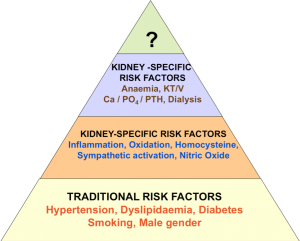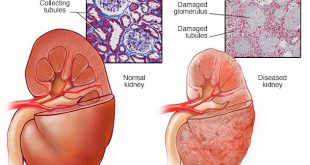Epidemiology
Patients with CKD have greatly increased risks of cardiovascular events and cardiovascular deaths. This increased risk begins when there is microalbuminuria even with normal GFR (glomerular filtration rate), or when GFR falls below half normal, i.e. about 50 mls/min/1.73m3. In fact, CKD patients are more likely to die of heart disease than to progress to kidney failure.3 Therefore for many patients with CKD, CVD is more important than the danger of developing more serious kidney disease.
Heart disease is the most common cause of death for people with kidney failure on dialysis.1,3 In Malaysia, CVD accounts for 38% of deaths in dialysis patients.1 Even after kidney transplant, CVD is the second commonest cause of death, after infection, accounting for a total of 29% of deaths in transplant patients in 2011.1
Why are CKD patients at increased risk of CVD?
Much of the problem comes from the fact that people with kidney disease often have many risk factors for heart disease. Most CKD patients have a combination of “traditional” and “kidney-specific” risk factors (Figure 1). With increasing levels of kidney impairment, the risk factors will increase.
Traditional CVD risk factors are those linked to a higher risk of heart disease in the general population and include the following:
- Smoking
- High blood pressure
- Obesity
- High cholesterol
- Poorly controlled diabetes
- Older age
- Physical inactivity
- Male gender
- Previous heart attack
Because diabetes and hypertension are the most common causes of kidney failure in Malaysia1, these traditional CVD risk factors are present in most people with CKD in our country.
In addition, patients with CKD have “kidney-specific” risk factors for CVD as a direct result of kidney disease itself and/or dialysis treatments. The link between these risks and heart disease is less well understood. “Kidney-specific” risk factors include:
- Anaemia
- Inflammation – a response by the body to harmful stimuli such as germs, damage cells or irritants
- Reduced glomerular filtration rate
- Urine protein including albumin
- Abnormal calcium and phosphate metabolism
- Excess content of water in the body (fluid overload)
- Immunosuppressive medications in renal transplant recipients which contribute to high blood pressure as well as elevated blood sugar, cholesterol and fat levels

Figure 1. CVD risk factors accumulate with advancing stages of CKD
(Ca=calcium, PO4=phosphate, PTH=parathyroid hormone, KT/V = a measurement of the adequacy of dialysis)
References:
- Lim, Y.N., Ong, L.M. & Goh, B.L. (Eds.) Nineteenth Report of the Malaysian Dialysis and Transplant Registry 2011. Kuala Lumpur.
- National Kidney Foundation. (2002). Clinical practice guidelines for chronic kidney disease: Evaluation, classification, and stratification. Am J Kidney Dis 39(Suppl 1):S204-5
- U.S. Renal Data System. (2004). Annual Data Report: Atlas of End-Stage Renal Disease in the U.S. NIH, National Institute of Diabetes and Digestive and Kidney Diseases, Bethesda, MD http://www.usrds.org/atlas04.aspx
| Last Reviewed | : | 12 May 2016 |
| Writer | : | Dr. Sunita Bavanandan |
| Accreditor | : | Dr. Hooi Lai Seong |
 PENDIDIKAN PESAKIT Kementerian Kesihatan Malaysia
PENDIDIKAN PESAKIT Kementerian Kesihatan Malaysia
